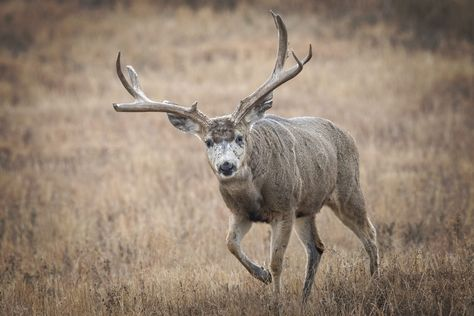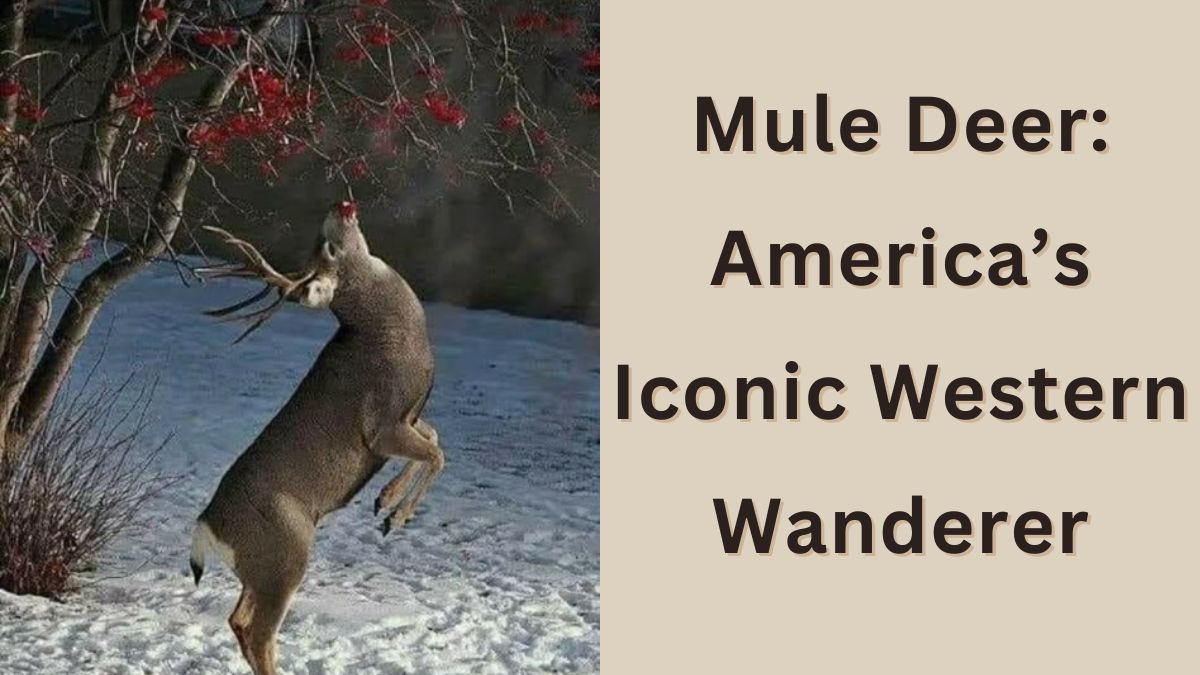Usually, the American West is connected with amazing landscape, a great abundance of species, and grand mountains. The mule deer is among the most identifiable species in this area. Because of their huge, ear-shaped antlers and unique spring-like movement, mule deer are favored among American hunters, conservationists, and wildlife aficioners.
This essay will address the unique qualities of mule deer, their habitat, their significance, and interesting facts about them—such as their rare variances, such the melanistic mule deer—that highlight their attractiveness.
What Is a Mule Deer?
Native to North America, the mule deer (Odocoileus hemionus) receives its name from the fact that its large, mule-like ears enable it to more successfully hear predators. Mule deer can be readily identified from their white-tailed deer forebears by their stocky physique, black-tipped tail, and antlers that split as they age rather than remain straight.
Although females often lack antlers, bucks (males) grow and then shed these spectacular antlers in late winter every year. Though most of them have a grayish-brown coat, the very dark fur of the black hair mule deer is what draws people to this species most.

One interesting variety is the melanistic mule deer, a genetic anomaly whereby excess melanin causes the deer’s coat to be excessively dark—sometimes virtually black. These deer are an interesting find for anyone who enjoy animals since they differ from their lesser cousins.
Mule Deer Habitat: Where They Roam
Mule deer are quite good on uneven ground. Their habitat ranges the western United States from the Great Basin to the Rocky Mountains and even certain sections of the Southwest. They like wide ground for grazing and locations with a mix of trees or heavy foliage for cover.
At higher altitudes, they can be observed summertime grazing on grasses and forbs. Essential for their life, they winter move to lower valleys in order to avoid deep snow. Keep a look out for the elusive black hair mule deer in shadowed forests even if their dark coats make them tough to see.
Sadly, habitat degradation brought on by urbanization, farming, and climate change stresses mule deer populations—even rare species like the melanistic ones. States like Montana and Nevada are working on conservation programs to protect their migratory routes and ensure these deer have freedom to wander.
Mule Deer Hunting: A U.S. Tradition
For many Americans, mule deer shooting is a custom brought down through the years rather than a hobby. Finding these elusive animals drives hunters to the Western plains and mountains each fall. States like Colorado and Wyoming enjoy mule deer hunting since regulated seasons ensure good numbers.
Though most hunters target the regular gray-brown deer, encountering a melanistic mule deer or a black-haired mule deer is a trophy worth bragging about given their rarity.
The National Deer Association says mule deer are prized for their meat (venison) as well as the thrill of the hunt. While certain areas allow harvesting to help to manage herd numbers, hunters usually target trophy males with massive, symmetrical antlers. If you are new to hunting, check local rules; every state has different bag restrictions and license requirements.
Why Mule Deer Matter
Wild mule deer are essential for the survival of the ecosystems they inhabit, not only a sight to behold. Being herbivores, they are very important in regulating the total topography of the area and plant life. Predators such wolves, mountain lions, and bears rely on them as prey, therefore preserving the balance of the food chain. Though their coat at birth is darker, even the rare black-haired mule deer fawns eventually help to complete this cycle.
Apart from their biological value, mule deer have cultural and financial relevance. By luring guests to national parks like Grand Teton and Yellowstone, they boost nearby businesses. For rural communities, mule deer-related hunting and tourism bring cash and employment.
Fascinating Mule Deer Facts
Big Ears, Big Advantage: Their ears’ capacity for independent rotation to find sounds helps them to avoid danger.
With a distinctive hopping motion known as stotting—where all four legs strike the ground simultaneously—mule deer flee predators.
Bucks can weigh up to 300 pounds; does are smaller, averaging 100–200 pounds.
One of the largest distances any terrestrial mammal in the Lower 48 travels—some mule deer wander over 100 miles between summer and winter ranges.
One of the rare dark beauties is the black hair mule deer fawn; its dark coat seems from birth and occasionally suggests a melanistic adult destiny.
Challenges Facing Mule Deer
The tenacity of mule deer carries some hazards. Roads and home building have split their habitat, therefore upsetting their migratory routes. Concerned about the spread of diseases like chronic wasting disease (CWD), which kills deer and elk, wildlife managers in many states—including Utah and Colorado—are worried about Climate change puts all mule deer—including the threatened black hair type—at peril since it will dry up the summer and change the winter food availability.
State governments and conservation organizations are mounting projects including habitat restoration and wildlife corridors. Through licensing fees, which support these initiatives, hunters also help.
How to Spot Mule Deer
Where might one find mule deer? See some isolated locations, such the Black Hills of South Dakota or the Oregon sagebrush plains. Since mule deer are most active at sunrise and sunset, early morning or late afternoon is the perfect times to see them. Because of their gray-brown coats, which fit the surroundings, binoculars are a great concept. In some lighting, though, a melanistic mule deer’s dark fur could be striking.
More than merely a deer, the mule deer reflects the American West. From the typical gray-brown buck to the rare melanistic mule deer and the amazing black hair fawn, wild areas support a varied spectrum of life. By acting to preserve their natural habitats and numbers, we can increase the likelihood that mule deer will continue to be a fixture of the American scene for many years to come.
FAQ’s
What’s another name for a mule deer?
The white tails of most mule deer end in a tuft of black hairs. They have large ears that move constantly and independently, from whence they get their name, “Mule” or “Burro Deer.”
What’s the difference between a mule deer and a regular deer?
The most obvious difference between these two species is their tails. The differences in the tails of these deer is the best and easiest way to differentiate between the two species. Mule deer have a white rump and a tail with a black tip at the end of it.
What is the best call for a mule deer?
Grunt and Bleat: Whether you need to pull a mule deer buck from behind a spruce or across a fence, two calls to get the job done are the grunt and bleat. Bucks grunt contentedly while trailing does and prowling for willing partners.

